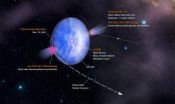Astronomers discover universe's most distant quasar
2011-06-30
(Press-News.org) A scientist at The University of Nottingham is part of a team of astronomers which has discovered the most distant quasar to date — a development that could help further our understanding of a universe still in its infancy following the Big Bang.
This brilliant and rare beacon, powered by a black hole with a mass two billion times that of the Sun, is by far the brightest object yet found from a time when the Universe was less than 800 million years old — just a fraction of its current age.
The object that has been found, named ULAS J1120+0641, is around 100 million years younger than the previously known most distant quasar. It lies at a redshift of 7.1 which corresponds to looking back in time to a Universe that was only 770 million years old, only five per cent of its current age. Prior to this discovery, the most distant quasar known has a redshift of 6.4, the equivalent of a Universe that was 870 million years old.
With only an estimated 100 bright quasars with a redshift of higher than 7 in the whole sky, their discovery is an extremely rare find.
Nottingham's Dr Simon Dye was on the team which made the discovery, detailed in the June 30 2011 edition of the journal Nature.
Dr Dye said: "Objects that lie at such large distance are almost impossible to find in visible-light surveys because their light is stretched by the expansion of the universe. This means that by the time their light gets to Earth, most of it ends up in the infrared part of the electromagnetic spectrum.
"It took us five years to find this object. We were looking for a quasar with a redshift higher than 6.5. Finding one this far away, at a redshift higher than 7, was an exciting surprise. This quasar provides a unique opportunity to explore a 100 million year window of the cosmos that was previously out of reach."
Quasars are very bright and distant galaxies that are believed to be powered by supermassive black holes at their centres. Their great brilliance makes them powerful probes to help study the period in the history of the Universe when the first stars and galaxies were forming.
The astronomers initially detected the record-holding quasar using the UK Infra-Red Telescope (UKIRT) located in Hawaii, as part of the UKIRT Infrared Deep Sky Survey (UKIDSS). The distance to the quasar was confirmed by observations made with the FORS2 instrument on the European Southern Observatory's Very Large Telescope (VLT) and instruments on the Gemini North Telescope. Because the object is comparatively bright, it is possible to perform a spectroscopic analysis, which entails splitting the object's light into its component colours, which in turn allows astronomers to determine the quasar's physical characteristics.
The observations show that the mass of the black hole at the centre of the new quasar was about two billion times that of the Sun. This very high mass is hard to explain to early on after the Big Bang. Current theories for the growth of supermassive black holes show a slow build up in mass as the compact object pulls in matter from its surroundings. According to these models, the mass of the quasar's black hole is not expected to be higher than one-quarter of the value now determined for ULAS J1120+0641.
The team is now speculating that the existence of such a massive black hole so early on in the history of the Universe means that current models for the growth of these objects may need to be revised.
INFORMATION:
The research was led by the Astrophysics Group at Imperial College London and also involved the European Southern Observatory in Germany, the Institute of Astronomy in Cambridge, the Astrophysics Research Institute at Liverpool John Moores University, the Institute for Computational Cosmology at the University of Durham, Universiteit Antwerpen in Belgium and the Joint Astronomy Centre in Hawaii.
END
ELSE PRESS RELEASES FROM THIS DATE:
2011-06-30
Although women generally have worse knee function and more severe symptoms before undergoing surgery for knee replacement than men, they recover faster after the operation. Men take longer to recover but, after a year, they catch up with women and there are no differences in surgery outcomes at that time. These findings by Thoralf Liebs, from Hassenpflug University of the Schleswig-Holstein Medical Center in Germany, and colleagues, are published online in Springer's journal Clinical Orthopaedics and Related Research.
Although research to date shows conflicting results, ...
2011-06-30
A new database of plants' traits will help scientists around the world learn more about how climate change is affecting ecosystems.
The availability of plant trait data in the unified global database promises to support a paradigm shift in Earth system sciences.
University of Minnesota researchers Peter Reich and Jacek Oleksyn, Department of Forest Resources, and Jeannine Cavender-Bares, Department of Ecology, Evolution, and Behavior, are members of the international collaborative that developed the database, which includes 3 million traits for 69,000 of the world's ...
2011-06-30
Our skin is a communicative wonder: The nerves convey temperature, pressure, shear forces and vibrations – from the finest breath of air to touch to pain. At the same time, the skin is the organ by which we set ourselves apart from our environment and distinguish between environment and body. Scientists at TUM are now developing an artificial skin for robots with a similar purpose: It will provide important tactile information to the robot and thus supplement its perception formed by camera eyes, infrared scanners and gripping hands. As with human skin, the way the artificial ...
2011-06-30
Tel Aviv — Parkinson's Disease, brought to public awareness by figures such as Michael J. Fox, is not just difficult to diagnose. It's also difficult to accurately estimate how many people actually suffer from the disease. Current statistics come from small-scale studies, usually based on information from hospital clinics, and no registries or formal databases exist to track how many people have the disease.
Dr. Chava Peretz of Tel Aviv University's School of Public Health at the Sackler Faculty of Medicine, Ph.D. student Orly Chillag-Talmor from Haifa University and ...
2011-06-30
Interruptions are frequent in football: Football players (m/f) spend on average 38 percent of the total game time not chasing the ball. This was established by sports scientists from the Chair of Training Science and Sports Informatics at TUM in a study of 56 football games. In some games, the interruptions took up as much as 53% of the time, thus exceeding the duration of the actual sports activity.
In sum, interruptions in men's and women's football are about the same. The individual interruptions, though, are significantly longer in men's football. Cheering a goal, ...
2011-06-30
A paper published online today in Nature reveals that glia play a key role in preventing the progression of the most prominent Rett Syndrome symptoms displayed by mouse models of the disease: lethality, irregular breathing and apneas, hypoactivity and decreased dendritic complexity. The discovery, funded in part by the Rett Syndrome Research Trust (RSRT) was led by Gail Mandel, Ph.D., an investigator of the Howard Hughes Medical Institute at Oregon Health and Science University.
Rett Syndrome, the most physically disabling of the autism spectrum disorders, is caused ...
2011-06-30
In December 2010, a pair of mismatched stars in the southern constellation Crux whisked past each other at a distance closer than Venus orbits the sun. The system possesses a so-far unique blend of a hot and massive star with a compact fast-spinning pulsar. The pair's closest encounters occur every 3.4 years and each is marked by a sharp increase in gamma rays, the most extreme form of light.
The unique combination of stars, the long wait between close approaches, and periods of intense gamma-ray emission make this system irresistible to astrophysicists. Now, a team using ...
2011-06-30
VIDEO:
University of Western Ontario researchers Jody Culham and Jason Gallivan describe how they can use a fMRI to determine the action a person was planning, mere moments before that action...
Click here for more information.
Bringing the real world into the brain scanner, researchers at The University of Western Ontario from The Centre for Brain and Mind (http://www.uwo.ca/its/brain/) can now determine the action a person was planning, mere moments before that action is actually ...
2011-06-30
VIDEO:
This GOES-13 satellite imagery shows the Chilean caldera still emitting a steady stream of ash, three weeks after the initial eruption on June 4, 2011. The cold winter wind from...
Click here for more information.
The Puyehue-Cordón volcano in Chile continues to spew ash that is still disrupting travel as far as Australia and New Zealand this week. A new animation of satellite imagery just released from the NASA/NOAA GOES Project shows the ash spewing from the ...
2011-06-30
Online parcel delivery specialist Parcel2Go has reaffirmed its view that companies in the UK should take measures to ensure their deliveries are not disrupted by industrial action.
Royal Mail released its annual report this week, which revealed a GBP120m loss for the year - equivalent to over GBP2m a week. Chief executive Moya Greene has said the business must change, and it is believed up to 43,000 jobs are at risk as mail centres across the country face closure. In response, union officials said that attempts to use employees as a political football would "inevitably ...
LAST 30 PRESS RELEASES:
[Press-News.org] Astronomers discover universe's most distant quasar


